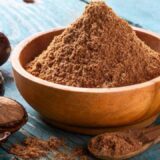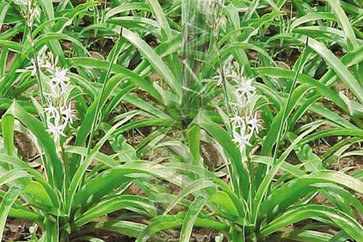Kakamachi (Solanum Nigrum) and Its Ayurvedic Benefits.
Kakamachi (Solanum nigrum), also known as Black Nightshade, holds a significant place in Ayurvedic medicine, where it is valued for its diverse therapeutic properties. In Ayurveda, this plant is considered to have a potent influence on balancing the doshas, particularly Pitta and Kapha.
It is known for its anti-inflammatory, detoxifying, and cooling properties, making it useful in treating conditions associated with excess heat in the body, such as inflammation, fever, and skin disorders. Ayurvedic practitioners have long used Kakamachi in the form of powders, decoctions, and external applications to treat a variety of ailments.
Kakamachi’s medicinal uses in Ayurveda extend to its role in supporting the liver, aiding digestion, and promoting overall detoxification of the body. The leaves, berries, and roots of the plant are commonly utilized for their ability to cleanse the blood and improve digestive functions.
Its bitter and slightly astringent taste is believed to help in pacifying Pitta, while also stimulating the digestive fire (Agni) to enhance metabolism. Additionally, Kakamachi is often used in Ayurvedic formulations to treat respiratory conditions, skin infections, and as a remedy for chronic ailments like gout and arthritis, where its anti-inflammatory effects are highly valued.
However, as with any powerful herb, Ayurveda emphasizes the importance of proper dosage and expert guidance to ensure its safe and effective use.
Vernacular names of Kakamachi (Solanum nigrum)
- Bengali: Kakamachi, Dudakamai
- English: Black nightshade, Common nightshade, Hound’s berry, Garden Nightshade
- Gujarati: Pludi
- Hindi: Makoi, Gurakani
- Kannada: Kaagehannina gida, Kaakamache, Kakkehannu
- Malayalam: Manithakkal, Kasumuthi, Karim thakkali
- Marathi: Kaamani, Ghati, Makoi
- Punjabi: Mako
- Tamil: Manattakkali, Thenna takali pullum, Milagetakkali
- Telugu: Kanchi ponda, Kamanchi-chettu
- Tulu: Kaachiponda
- Urdu: Makoh
Sanskrit Synonyms of Kakamachi (Solanum nigrum)
1. Bahuphala – The plant yields many fruits.
- It is known for producing an abundance of berries in clusters.
2. Sarvatikta, Bahutikta – The fruits are bitter.
- This bitterness is a key characteristic of the plant’s medicinal properties.
3. Gucchaphala – The fruits are found in clusters.
- These clustered fruits are often a distinguishing feature of the plant.
4. Kushtagni – Treats skin diseases.
- The plant has been traditionally used to alleviate various skin conditions.
5. Gucchaphala, Bahuphala – Numerous fruits in a bunch.
- The fruit clusters are densely packed, often making them stand out visually.
6. Kakini, Vayasi, Kakamachi, Kakahva – The fruits are liked by crows.
- This suggests that the plant’s berries are highly attractive to birds.
7. Jaghanephala, Matsyakshi, Rasayani – Associated with medicinal properties.
- These synonyms emphasize its use in rejuvenating treatments and health tonics.
8. Gudaphala, Svadupakaphala – Sweet fruits.
- The sweetness of the fruits, though rare, indicates its potential for certain medicinal applications.
Habitat of Kakamachi (Solanum nigrum)
Size:
- The shrub typically grows to a height of 4 to 5 feet.
Leaves:
- 3 to 8 inches long
- Sharp edges with a thinner underside
- Simple, deciduous, and ovate in shape
Fruits:
- Black in color with a sparkly appearance
- Contains 10 to 20 seeds
Roots:
- Can grow up to 1 foot in length
- 1 to 2 inches thick, swollen, and tender
Flowers:
- Pale lavender in color
- 6 to 12 mm long
- Blooming period: June to July
- Solitary, pendant, auburn flowers
- Campanulate (bell-shaped) and double-petaled
Geographical Distribution:
- Found mainly in middle and southern Europe
- In India, it grows wildly in hilly regions such as the Kashmir valleys
Ayurvedic Properties of Kakamachi (Solanum nigrum)
- Rasa (Taste) – Tikta (Bitter): The plant has a distinctly bitter taste, which is key to its therapeutic effects.
- Guna (Qualities) – Laghu (Light), Snigdha (Slimy): It has a light, somewhat dry texture with a slimy consistency, which influences its action on the body.
- Veerya (Potency) – Anushna (Not Hot): It is considered to have a mild potency, not excessively hot or cold in nature.
- Vipaka (Post-digestive Effect) – Katu (Pungent): After digestion, the plant imparts a pungent taste, which adds to its stimulating and digestive qualities.
- Karma (Actions) – Tridoshagna (Reduces all three doshas): It helps balance all three doshas (Vata, Pitta, and Kapha), making it a powerful harmonizer for the body.
According to Bhojana Kutuhalam (Twelfth Chapter), Kakamachi (another name for Belladonna) is described as:
- Pungent and bitter in taste, with a hot potency.: This combination helps to alleviate Kapha dosha and clear excess mucus or fluids from the body.
- Medicinal Uses: It is effective in treating colicky pain, hemorrhoids, edema (fluid retention), skin diseases, and itching.
Its ability to address such conditions highlights its diverse therapeutic benefits.
Traditional Uses of Kakamachi (Solanum nigrum)
Here are some traditional uses of Kakamachi (Solanum nigrum), a plant valued for its healing properties in various cultures.
1. Rasayani – Anti-aging, causes cell and tissue rejuvenation.
- It promotes overall vitality, enhancing longevity by rejuvenating tissues and slowing down the aging process.
2. Hrudya – Acts as a cardiac tonic, congenial for the heart.
- This property supports heart health by strengthening the heart, improving circulation, and maintaining cardiovascular balance.
3. Vrushya – Aphrodisiac, improves vigor.
- Kakamachi is known to enhance sexual vitality and improve energy levels, acting as a natural aphrodisiac.
4. Sara – Induces mobility, causes diarrhea, purgation, relieves constipation.
- The plant helps in promoting digestion and regular bowel movements, making it effective for treating constipation and detoxification.
5. Svarya – Improves voice tone and quality.
- This traditional use enhances the voice’s clarity and richness, making it beneficial for singers or individuals with vocal strain.
6. Netrahita – Good for eyes.
- Kakamachi is used to improve vision and soothe eye-related issues, contributing to overall eye health.
7. Shukrada / Shukrala – Improves sperm and semen quantity and quality.
- This use enhances male reproductive health by boosting sperm count and improving semen quality for fertility purposes.
These traditional uses highlight Kakamachi’s role in promoting overall health and vitality across various bodily functions.
Medicinal Uses of Kakamachi (Solanum nigrum)
Here are several benefits and medicinal uses of Kakamachi (Solanum nigrum), a versatile plant known for its therapeutic properties.
1. Skin Diseases:
- The leaves of the Kakmachi plant are applied to areas affected by skin conditions like scabies, ringworm, and vitiligo.
- This topical application helps in reducing inflammation and promoting skin healing.
- The antiseptic properties of the leaves also assist in preventing infection in affected areas.
3. Localized Swelling:
- A poultice made from the leaves is applied externally to treat localized swelling.
- The anti-inflammatory properties of the leaves help in reducing pain and swelling in the affected area.
- This treatment is especially effective in alleviating swelling caused by insect bites or injuries.
4. Herpes:
- A paste made from the leaves of Solanum nigrum, combined with ghee, is applied to the affected area to treat herpes.
- This remedy aids in reducing the itching, inflammation, and discomfort associated with herpes outbreaks.
- It also speeds up the healing process by providing a cooling and soothing effect on the lesions.
5. Eye Diseases:
- In cases of conjunctivitis and itching, the eyes are fumigated with leaves applied with ghee or butter to reduce irritation.
- This method helps soothe the eyes and alleviate symptoms of redness, swelling, and itching.
- It also provides relief from dryness and burning sensations in the eyes.
6. Hair Health:
- To strengthen hair roots and improve scalp hair color, oil processed with sesame oil, Kakmachi leaves, and sesame seeds is used as nasal drops.
- This oil also helps in promoting hair growth and nourishing the scalp, contributing to overall hair health.
- Regular use of this oil can help prevent hair fall and reduce dandruff.
7. Urticaria (Hives):
- A mixture of pounded ginger and Kakmachi juice (15-20 ml) is given to treat urticarial patches.
- This remedy helps in reducing the itching and irritation associated with hives, providing relief from skin rashes.
- It also works as a natural anti-inflammatory agent, calming the skin and reducing the severity of outbreaks.
8. Rat Poisoning:
- Ghee cooked with Kakmachi leaf juice is effective in treating rat poisoning.
- This traditional remedy aids in neutralizing toxins and detoxifying the body in cases of rodent poisoning.
- It can also help in minimizing the harmful effects of accidental ingestion of rat poison.
9. Cough and Asthma:
- The fresh juice of the leaves and fruits (10-15 ml) is administered to treat cough and asthma.
- This remedy helps in clearing respiratory pathways and soothing inflammation in the lungs, making breathing easier.
- It also promotes the expulsion of mucus, easing congestion and improving airflow in the chest.
10. Splenomegaly and Hepatomegaly:
- A decoction of the leaves and fruit (30-40 ml) is given to treat enlargement of the spleen and liver.
- This treatment supports the detoxification process and helps reduce swelling in the abdominal area caused by organ enlargement.
- It also improves liver function by stimulating bile production and helping in digestion.
11. Fever and Nausea:
- A cold infusion of the fruits and leaves (30-40 ml) is used to treat fever and nausea.
- The cooling properties of the plant help reduce fever and alleviate feelings of nausea and discomfort.
- This infusion also helps in rehydrating the body and restoring balance during feverish conditions.
12. Opium Poisoning and Rat Bites:
- The juice of the plant is used as an antidote for opium poisoning and to treat rat bites.
- It works by neutralizing toxins and promoting quicker recovery from both opium exposure and rat venom.
- This remedy can also assist in reducing swelling and pain from the bite while improving overall circulation.
13. Oral Cavity Diseases:
- Gargling with a decoction of the plant helps treat oral conditions like ulcers and gingivitis.
- This gargle helps fight bacterial infections and reduces inflammation in the gums and mouth.
- It also promotes faster healing of mouth sores and strengthens the gums, preventing further infections.
14. Ear Ache:
- The fresh juice of the leaf is slightly heated and used as ear drops to alleviate ear pain.
- This remedy helps in soothing the pain and reducing any inflammation within the ear canal.
- It also acts as a natural disinfectant, preventing ear infections and promoting ear health.
Note: While the plant offers various medicinal benefits, it should be used with care under professional supervision, as it can be toxic in large doses.
Ayurvedic Medicines Containing Kakamachi (Solanum nigrum)
1. Cirrhonil Syrup:
Cirrhonil Syrup is a proprietary Ayurvedic medicine used in the treatment of liver disorders. It helps in promoting liver health by improving detoxification and supporting liver function.
2. Amlycure Tablet:
Amlycure Tablet is a proprietary Ayurvedic medicine used for hepato-protective action. It aids in protecting and rejuvenating liver cells, making it effective for liver dysfunctions.
3. Ayuliv Syrup :
Ayuliv Syrup is a proprietary Ayurvedic medicine indicated in the treatment of liver dysfunctions, jaundice, and hepatitis. It supports liver health by improving digestion and detoxification processes, particularly in cases of jaundice.
4. Kalakuta Rasa:
Kalakuta Rasa is an Ayurvedic medicine in tablet form, used in the treatment of chronic fever, bronchitis, diabetes, urinary tract infections, etc. This medicine contains heavy metal ingredients, so it should only be taken under strict medical supervision.
Hridayarnava Rasa is an Ayurvedic medicine in tablet form, used in the treatment of cardiac disorders with difficulty in breathing and heaviness in the chest. It helps improve heart function and ease symptoms associated with cardiac conditions, such as breathlessness and chest heaviness.
6. Maha Vishagarbha Taila:
Maha Vishagarbha Taila is an oil-based formulation used for external application to treat neuromuscular conditions, sciatica, and other Vata dosha disorders. It relieves pain, stiffness, and inflammation, especially in conditions related to the nervous system and joints.
7. Brihat Sarva Jwarahara Lauh:
Brihat Sarva Jwarahara Lauh is an Ayurvedic medicine in tablet form, used in the treatment of fever, anemia, indigestion, splenomegaly, and cough. It balances the body’s systems by improving overall health and treating conditions like fever, digestive issues, and spleen enlargement.
These Ayurvedic formulations demonstrate the versatility of Kakamachi in promoting liver health, improving digestive functions, and addressing various systemic disorders.
Note: However, it’s important to consult a healthcare provider before using these medicines, especially those containing heavy metals.
Parts Used:
- Fruit
- Whole Plant
Dosage:
- Juice: 10 to 20 ml of the whole plant
- Fruit Powder: 2 to 3 g
- Distillate of Plant: 20 to 25 ml
It’s important to follow the prescribed dosage and consult a healthcare professional, as Atropa Belladonna can be toxic in excessive amounts.
FAQ’s
1. What is Solanum nigrum called in India?
In India, Solanum nigrum is commonly known as Kakamachi or Manathakkali in different regions, depending on the local language.
2. What is the common name for Kakamachi in India?
Kakamachi is often referred to as Black Nightshade in India, though it is also known as Manathakkali in some areas.
3. What is the benefit of Kakamachi?
Kakamachi is known for its anti-inflammatory, detoxifying, and antioxidant properties. It is traditionally used in Ayurveda to treat fever, liver diseases, skin conditions, and digestive issues.
4. What is the medicinal benefit of Solanum nigrum?
Solanum nigrum has various medicinal benefits, including its use as a remedy for fever, liver ailments, spleen enlargement (splenomegaly), and rodent bites. It also helps manage skin disorders such as vitiligo and is known to improve digestive health.
5. Is Solanum nigrum poisonous?
Yes, Solanum nigrum can be toxic if consumed improperly. Its berries and other parts contain solanine, a harmful alkaloid. It is important to use the plant under professional guidance to avoid poisoning.
6. Can we eat black nightshade?
While Black Nightshade (Solanum nigrum) is consumed in some cultures after proper preparation, it can be toxic if eaten raw or in large quantities. Only the ripe berries and well-cooked leaves are typically safe to consume.
7. Is nightshade poisonous to humans?
Many plants in the nightshade family, including Solanum nigrum, can be poisonous to humans due to the presence of solanine, a toxic compound. However, with proper preparation, some varieties are used for medicinal purposes.
8. What is the use of Manathakkali?
Manathakkali (another name for Kakamachi) is used in Ayurveda to treat a variety of ailments, including liver diseases, fever, digestive issues, and skin disorders. It is also used as a remedy for opium poisoning and rodent bites.
9. Can you touch black nightshade?
While it is generally safe to touch Black Nightshade, care should be taken not to consume any part of the plant without proper knowledge or preparation, as it can be toxic in certain forms.
10. Is Manathakkali a herb or shrub?
Manathakkali (Solanum nigrum) is a shrub-like herb that grows in various regions, commonly found in tropical and subtropical areas.
11. What is the benefit of black nightshade?
Black Nightshade offers several health benefits, including its anti-inflammatory, antioxidant, and antimicrobial properties. It is traditionally used for treating digestive disorders, skin conditions, and respiratory issues.
12. Are tomatoes a nightshade?
Yes, tomatoes belong to the nightshade family (Solanaceae), along with other vegetables like potatoes, peppers, and eggplants.

























